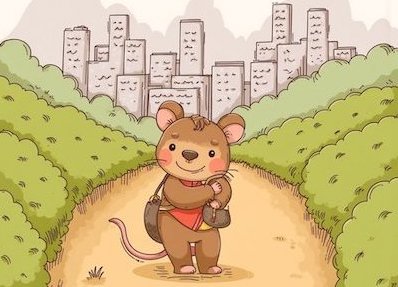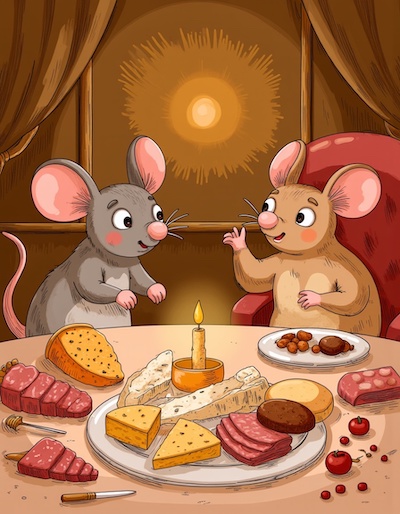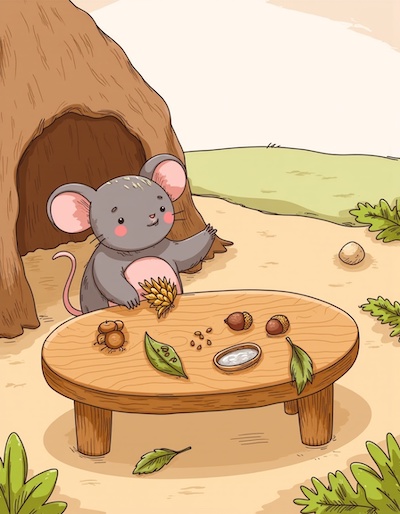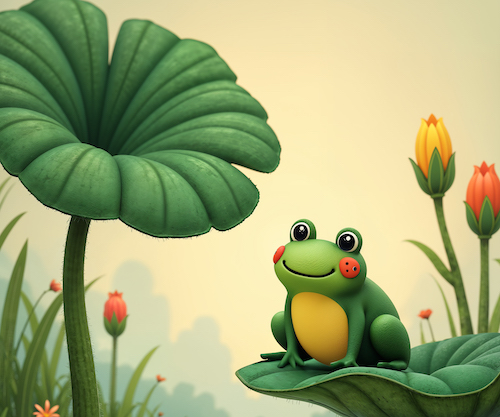The Town Mouse and Country Mouse: Timeless Aesop’s Fables

Among the most cherished bedtime stories in the collection of Aesop’s fables, “The Town Mouse and the Country Mouse” offers valuable lessons about contentment, lifestyle choices, and different perspectives. This comprehensive guide helps educators utilize this classic tale to meet Common Core Standards while engaging young readers.
The Story: The Town Mouse and the Country Mouse
A Town Mouse once visited a relative who lived in the country. The country mouse offered his best: simple meals of acorns, wheat, and water. The town mouse ate little and said, “My poor cousin, I wonder how you can manage to live here! Come with me to the city, and I will show you how to really live.”
The country mouse agreed to visit the city. When they arrived at the town mouse’s home, they found the table set with a feast: cheese, meat, honey, dried fruits, and fine bread. Just as they began to eat, a cat appeared at the door. The mice scurried to hide. When they emerged, before they could take another bite, they had to run from a dog. This happened several times.
Finally, the country mouse bid farewell to his cousin, saying, “Goodbye, cousin. I can see that you live in luxury, but I prefer my quiet life with simple food and peace to your feast with danger and fear.”

Poverty with security is better than plenty in the midst of fear and uncertainty.
Teaching CCSS.ELA-LITERACY.RL.5.9
This standard requires students to “compare and contrast stories in the same genre on their approaches to similar themes and topics.” This fable is particularly useful because:
- It offers clear themes about:
- Contentment vs. ambition
- Simple vs. luxurious lifestyles
- Peace vs. excitement
- Safety vs. risk
Reading activities for kids on the Aesop Fable
- Compare/Contrast Chart:
- Town Mouse’s Life vs. Country Mouse’s Life
- Benefits and Drawbacks of Each Lifestyle
- Character Analysis:
- Personality traits of each mouse
- Motivations and values
- Decision-making processes
Classroom Reading Activities
- Writing Prompts:
- Which mouse made the better choice? Why?
- Write about a time you had to choose between excitement and safety
- Create a different ending for the story
Creative Projects:
- Draw scenes from both settings
- Create a menu for each mouse’s meal
- Role-play the story
Discussion Questions:
- What makes a good life?
- Would you rather live in the city or country? Why?
- Is having more always better?

Comprehension Questions (Free Response)
- Compare and contrast how the town mouse and country mouse view the concept of “the good life.” Support your answer with evidence from the text.
- How does each mouse’s environment influence their perspective on what makes life worth living? Provide specific examples from the story.
- What role does setting play in developing the theme of the story? Discuss both the country and city settings.
- Compare this fable’s approach to contentment with another Aesop’s fable you’ve read. How are they similar and different?
Multiple Choice Questions
- How does the town mouse’s reaction to the country life differ from the country mouse’s reaction to city life?
a) The town mouse complains openly while the country mouse stays silent
b) The town mouse is polite but dismissive while the country mouse is frightened but diplomatic
c) Both mice enjoy each other’s lifestyles equally
d) Both mice immediately reject each other’s ways of living - Which statement best describes the different ways the two mice approach the concept of a good life?
a) The town mouse values luxury while the country mouse values peace
b) Both mice value excitement above all else
c) The country mouse wants wealth while the town mouse wants simplicity
d) Neither mouse understands the value of contentment - How does this fable’s approach to the theme of contentment compare to other Aesop’s fables?
a) It’s the only fable that addresses contentment
b) It shows both perspectives rather than just one
c) It focuses only on material wealth
d) It presents contentment as unimportant - What literary device does Aesop primarily use to develop the theme in this story?
a) Flashbacks
b) Internal monologue
c) Contrast between characters and settings
d) Symbolic dreams
Answers
1.d) Both mice immediately reject each other’s ways of living
2.c) The country mouse wants wealth while the town mouse wants simplicity
3.b) It shows both perspectives rather than just one
4.c) Contrast between characters and settings
Extension Activities on Story
- Genre Study:
- Compare this fable with other stories about choices
- Analyze how different authors approach similar themes
- Create a new fable with a similar moral
Cross-Curricular Connections for this fable:
- Social Studies: Compare urban and rural life
- Science: Study different mouse habitats
- Art: Illustrate the two settings
- Math: Create and solve word problems based on the story
Conclusion
The Town Mouse and the Country Mouse remains one of the most effective bedtime stories for teaching valuable life lessons. As an educational tool, this fable offers rich opportunities for meeting CCSS.ELA-LITERACY.RL.5.9 while engaging students in meaningful discussions about life choices and contentment. Whether used in classroom instruction or as a bedtime story, this tale from Aesop continues to resonate with readers of all ages.

FAQ on The Town Mouse and the Country Mouse
The main theme of this fable is the contrast between two different ways of living—the simplicity and safety of rural life versus the luxury and risks of urban life. It explores how different environments offer unique experiences and challenges, often emphasizing that contentment comes from valuing your own surroundings.
The moral of the story is often interpreted as “Better a simple, safe life than a rich, risky one.” It encourages readers to find satisfaction in a modest life and be cautious about being enticed by luxuries that come with greater risks or discomfort.
This fable remains relevant as it highlights a common dilemma between urban and rural lifestyles, where many people are drawn to cities for opportunities but may also yearn for the peace and simplicity of the countryside. It serves as a reminder to consider one’s own values and to find contentment in a lifestyle that suits one’s needs and personality.
Children can learn about appreciating the life they have while understanding the differences between other ways of living. It also teaches them the importance of safety over unnecessary risks and encourages them to value the simplicity and security of their surroundings.



